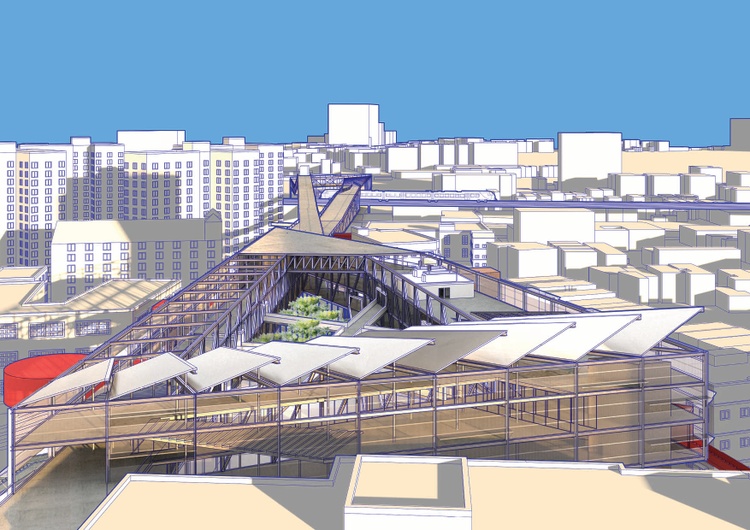Top Factors to Select CDA Architects for Your Residential or Commercial Layouts
Understanding the Collaborative Process Between Architects and Designers in Modern Building Projects
The joint procedure in between engineers and designers is crucial in modern building and construction tasks, as it harmonizes style intent with design usefulness. Exploring these characteristics reveals understandings that can dramatically affect job end results and total industry requirements.
The Importance of Collaboration
The joint harmony between designers and designers is important for the successful awareness of any kind of building and construction job. This collaboration brings together distinct experience and viewpoints, enabling the integration of innovative style with practical design services. By interacting, engineers and engineers can ensure that a project not only fulfills visual and practical demands however also adheres to safety, sustainability, and financial constraints.
Cooperation fosters a common vision, helping with the placement of goals and expectations from the start. This placement is vital in attending to possible obstacles and mitigating dangers that could arise during the job lifecycle. Moreover, a joint strategy permits the effective allowance of resources, enhancing both time and cost.
The importance of collaboration reaches the repetitive procedure of style and building and construction, where responses from designers can educate building decisions, leading to more possible and lasting designs. Alternatively, architects can motivate designers to believe creatively concerning exactly how to attain architectural honesty without endangering imaginative intent. Ultimately, the collaborative partnership in between engineers and engineers is not simply useful; it is essential to the production of top quality, functional, and ingenious constructed environments that meet the demands of culture.
Interaction Strategies and Devices
Reliable interaction strategies and tools are essential for fostering collaboration in between designers and engineers throughout the task lifecycle. Developing clear networks of interaction is necessary to make certain that all staff member are aligned with job goals, timelines, and duties. Routine conferences, both in-person and digital, provide chances for stakeholders to go over development, address issues, and make educated choices.
Using task administration software program, such as BIM (Building Details Modeling) platforms, boosts partnership by allowing real-time sharing of style adjustments and technological specifications. These tools help with openness, enabling engineers and engineers to envision modifications and analyze their effect on the total job.

Shared Goals and Job Vision

Developing common objectives includes open discussion and a complete understanding of each technique's contributions. Architects typically concentrate on design intent, spatial connections, and individual experience, while engineers emphasize structural honesty, systems functionality, and continue reading this compliance with regulations (cda architects). When these viewpoints are straightened, the result is a natural task that abides by both innovative goals and technical feasibility
In addition, a distinct job vision promotes liability among employee, motivating each individual to take possession of their function in achieving the wanted outcome. Routine check-ins and collaborative workshops can further reinforce this dedication, permitting changes to be made as the task evolves. Inevitably, a shared vision not just enhances teamwork but likewise boosts the high quality of the final deliverable, leading to successful task conclusion.
The Role of Innovation
Leveraging technology has actually become crucial in boosting cooperation between designers and engineers. The assimilation of advanced software program tools helps with real-time interaction and information sharing, allowing groups to function a lot more efficiently and effectively. Structure Information Modeling (BIM) stands out as a crucial innovation, permitting both architects and designers to develop thorough 3D versions that envelop style intent and structural stability. This shared graph lessens misunderstandings and simplifies the decision-making procedure.
Additionally, cloud-based platforms enable smooth collaboration, permitting task stakeholders to accessibility and update project data from anywhere. This fosters a society of transparency and liability, as modifications can be tracked and assessed in real-time. Additionally, mobile applications more enhance interaction, giving on-site groups with instant accessibility to project specs and updates.
Arising modern technologies such as fabricated intelligence and machine discovering are also beginning to contribute in predictive evaluation, helping groups recognize potential problems prior to they emerge. Eventually, the duty of modern technology in architecture-engineering partnership not only improves operations effectiveness yet additionally improves innovation, bring about even more effective job end results. By embracing these technological innovations, architects and designers can guarantee a more natural and efficient joint procedure throughout the building lifecycle.
Situation Research Studies in Effective Partnerships
Many case research studies illustrate the extensive effect of efficient partnerships between engineers and engineers on job outcomes. One noteworthy example is the cooperation on the High Line in New York City City, where landscape designers, engineers, and city planners collaborated to change a deserted railway right into a dynamic public park. This multidisciplinary technique not only improved the visual quality however additionally guaranteed structural security and ecological sustainability.
An additional excellent case is the layout and construction of the Sydney Concert Hall. The collaboration between designer JÃ ¸ registered nurse Utzon and structural designer Ove Arup exemplified ingenious analytical. Their cooperation permitted the renowned shell-like design while dealing with complex design challenges, eventually bring about a classic architectural masterpiece.
The Burj Khalifa website link in Dubai better demonstrates the significance of collective efforts. cda architects. The combination of architecture and design expertise enabled the project group to attain unprecedented webpage heights while adhering to safety and security policies and aesthetic vision
These instances emphasize the significance of communication, trust fund, and shared goals. In today's complex building setting, such collaborations are vital to browsing obstacles and supplying tasks that meet both practical and visionary objectives.
Final Thought
In verdict, the collaboration between designers and engineers is important for the success of contemporary building and construction jobs. Efficient interaction strategies, a shared job vision, and the integration of sophisticated modern technologies are vital parts that facilitate this partnership. By fostering a society of liability and leveraging tools such as Structure Info Modeling (BIM), groups can browse project complexities, making sure that aesthetic, practical, and sustainability objectives are accomplished. Eventually, this synergy causes ingenious and successful task end results.